By Nancy Cronin
Executive Summary
- We are at a critical juncture where innovative products and services are sorely needed to respond to the growing market needs.
- Any problem to solve in the aging in place landscape can quickly be turned to an opportunity to invent! Do you know how to do this?
- There is a timely opportunity to invent in this space and use the power of intellectual property (IP) to protect your innovative efforts.
What is “Aging in Place”? Why is it important?
“Aging in place” is exactly what it sounds like: remaining in your home as you grow older. Historically, the elderly lived with family as they aged. Today, this model has evolved to more prevalence of institutional care such as assisted living and nursing care facilities. However, there are multiple issues with this model, including high cost, inconsistent quality, lack of independence and control over one’s life, and little room for customization. The COVID-19 pandemic also presented new issues with spread of disease and lockdowns that prevented family visitation and much needed socialization.
Thus, a way to stay at home understandably appeals to aging people. Studies consistently show a high preference to remain at home. One 2020 study conducted in Ontario, Canada found that over 90% of the ~1000 seniors surveyed preferred to stay at home versus a long-term care facility, provided that sufficient support was available.
Scarcity of Caregivers
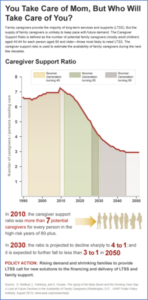
Caregivers may also become more scarce based on the increasing number of those needing care. The baby boomers are quickly becoming the growing wave of an aging population. One demographer projects that the percent of the US population over 65 will grow from 14% in 2014 to 24% by 2060. The ratio of caregivers will not keep up, per projections made by an AARP report (see Figure 1). While the ratio of caregivers to those needing care was 7 to 1 in 2020, by 2030 that ratio is projected to be 4 to 1. This will inevitably lead to higher demand, increased cost for care, and difficulty in procuring that care for seniors.
The figures are sobering. Something must be done to meet the needs of an aging population, with respect to medical requirements, activities of daily living, financial management, personal safety, and socialization/recreation.
Aging in Place Market Size
In 2019, the market for aging in place was estimated to be $151 billion USD, with an annual growth rate of 13%. The opportunity to create useful, meaningful, and valuable products and services in this sector is substantial. The market shows no sign of waning based on population and demographic drivers.
Fortunately, the baby boomers have one potential advantage over previous generations: contrary to public perception, they are more tech-savvy. Technology icons who helped build the modern world, like Bill Gates and Steve Wozniak, are boomers. Generation X, who will reach retirement age in the coming decades, is even more technology oriented.
This is where the potential for innovation, invention, and IP comes into play. We are at a critical juncture where innovative products and services are sorely needed to respond to the growing market needs.
The Aging in Place IP Landscape
The aging in place space is very broad. It encompasses multiple products and technologies that are required to maintain a healthy lifestyle in old age. When considering the IP in this area, many types of inventions must be included to cover all the needs within a home. An in-depth report on the aging in place market conducted by The Holding Co. and Pivotal Ventures discusses details behind the $151 billion USD market. A 2017 AARP/Parks Associates report portrays one way of looking at the aging in place IP landscape with six areas of opportunity (see Figure 2).
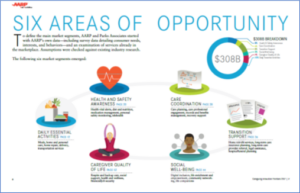
The six areas shown above include:
- Daily Essential Activities
- Meals, home, and personal care; Home Repair; Home Delivery, Transportation Services
- Health & Safety Awareness
- Health Vital Alerts, Diet & Nutrition, Medication Management, Personal Safety Monitoring, Telehealth
- Care Coordination
- Care Planning, Care Professional Management, Records and Benefit Management, Recovery Support
- Social Well-Being
- Digital Inclusion, Life Enrichment and Empowerment, Community networking, Life Companion
- Transition Support
- Home Retrofit Services, Long-Term Care Insurance Planning, Long-Term Care Provider Referral, Legal Assistance, Hospice/Funeral Planning
- Caregiver Quality of Life
- Respite and Backup Care
- Social Support
- Health and Wellness
- Financial/Job Security
Note that any one company may view the IP landscape differently for their specific product and technology focus area. This article depicts a high-level view of the space, within which many sub-categories can be derived and studied. A company wishing to get a more granular view of their area of expertise will want to conduct a more detailed assessment of the major players and IP owners in that space.
Each of these six areas offer interesting new opportunities for invention and IP to respond to aging in place needs.
Problems to Solve in the Aging in Place Landscape
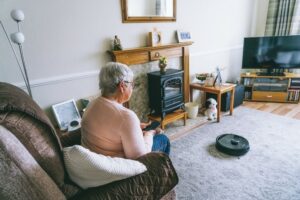 Plenty of products and services already exist that can assist the elderly with their lives at home. But problems and challenges often arise. These problems provide numerous opportunities for invention and improvement to current products and services.
Plenty of products and services already exist that can assist the elderly with their lives at home. But problems and challenges often arise. These problems provide numerous opportunities for invention and improvement to current products and services.
A 2019 paper published in Healthcare journal described the survey results of a San Diego retirement community, restricted to those living independently (as opposed to assisted living or skilled care). A common theme in the comments from the focus group was frustration in the design of products and the difficulty in interacting with technology. Many products and technology presumed a level of knowledge or a vocabulary that members of the focus group did not have. Some example quotes from the study follow, with brief observations on invention opportunities added:
Devices Are Hard to Setup
- “To get email hooked up, to get this done, to get the keyboard . . . all that stuff, and a lot of folks just give up.”
- Potential solution: a senior friendly installation process, that includes a video and captioned walkthrough of the steps – perhaps accessed from a QR code that directs the customer to aim the camera at the code.
Device Are Hard to Use with Limited Mobility
- “One of the biggest frustrations that I’ve seen was folks with power carts and a lot of them, to charge the battery, the plug is way down underneath your seat …. Couldn’t bend over to put it in, can’t see it….”
- Potential solution: design features built into products that consider limited mobility, eyesight, reach and flexibility.
Devices Are Too Complex, Too Many Options
- “Why don’t they have a senior version or an app that can get to on, off, volume up/down, channel, and make it kind of simple?”
- Potential solution: “Senior mode” incorporated into software and hardware that simplifies use for common home products. This may mean larger fonts, fewer buttons/modes/choices, and safety features such as auto-off.
 It is presumptuous to assume that your current products will work well for aging customers. In brainstorming and invention sessions, new features and characteristics should be included that help address the unique challenges that face older people. These characteristics might include:
It is presumptuous to assume that your current products will work well for aging customers. In brainstorming and invention sessions, new features and characteristics should be included that help address the unique challenges that face older people. These characteristics might include:
- Simplified interface
- Training and education
- Easy to use implementation instructions
- Hands free operation
- Maintenance support
- Reminders
- Safety features
Any problem can quickly be turned to an opportunity for invention! Do you know how to do this?
Technology Enhancements for Aging in Place
The advent of low-cost sensors, robotics, easily built software, and the Internet of Things all radically increase the impact of aging in place solutions. Critical monitoring can be conducted wirelessly and remotely by medical personnel and family. Whether it be fall detection, location monitoring, or medication reminders, all these functions can now be designed to assist the elderly without more intrusive equipment or 24/7 caregiver presence.
Aging in Place Patent Examples: Philips and Care Innovations
 Evidence already exists in the patent literature that companies are integrating technology into aging in place solutions. A Philips patent US10810855B2, System and method for monitoring activities of daily living of a person, collects lighting system data in the home to show activity changes, and connects through the cloud to communicate that information to a caregiver.
Evidence already exists in the patent literature that companies are integrating technology into aging in place solutions. A Philips patent US10810855B2, System and method for monitoring activities of daily living of a person, collects lighting system data in the home to show activity changes, and connects through the cloud to communicate that information to a caregiver.
A similar patent, owned by Care Innovations LLC, uses proximity sensors instead of the lighting system (US8659423B2, Smart display device for independent living care). This approach uses a sensor network to detect interaction with areas of the home associated with activities of daily living. It can also initiate reminders or prompts to the resident to, for example, turn off an appliance after use.
One can imagine innumerable inventions that use the power of sensing, computing, and wireless transmission to allow people to stay in their homes instead of moving to care facilities. Companies need to integrate these technology enhancements into their products and services where they can best serve those who are aging in place.
How will you integrate advanced technology into your products and services?
Where to Invent in the Aging in Place Landscape
Based on market trends, the problems to be solved, and the technology options that exist, many lucrative innovation opportunities exist. Here are some specific ideas within each of the six opportunity areas identified by AARP (see Figure 2) to consider for invention development. Any of these topics could be the focus of a custom-designed invention session, where concepts are strategically created to solve problems using any designated technology.
Daily Essential Activities: Meals
 Seniors often skip meals because they are too tired to cook. They may not have the knowledge or access to nutritional information that they can use in a practical way. Specific medical needs and dietary restrictions may also come into play. An existing product called the “Tovala” smart oven and meal service is designed to be ultra-simple to use. Other new devices and business models that are specific to seniors can easily be created in this area.
Seniors often skip meals because they are too tired to cook. They may not have the knowledge or access to nutritional information that they can use in a practical way. Specific medical needs and dietary restrictions may also come into play. An existing product called the “Tovala” smart oven and meal service is designed to be ultra-simple to use. Other new devices and business models that are specific to seniors can easily be created in this area.
Health & Safety Awareness: Safety Monitoring
Safety becomes paramount for aging people. An injury can take weeks to heal. Dangers from appliances left unattended can end in tragedy. Fall prevention is critical to avoid the downward spiral that is often observed after an elderly person breaks a hip and is no longer mobile. While numerous fall detection devices exist, far fewer systems help prevent falls. One company, Virtusense, uses artificial intelligence (AI) and machine vision to identify balance, gait, and function deficits. The AI then makes recommendations to combat the deficits to reduced fall incidents. Many more safety issues exist where simply identifying them is insufficient. How can technology be used to anticipate and prevent an event from occurring?
Care Coordination: Records Management
There is no standard, centralized system in which a person’s medical and care information is kept. It is generally up to the patient or their family to organize this information. Doctors seldom coordinate with one another, and confusion is common over medications, treatment, follow up visits, and scheduling. Online personal health records are notoriously quirky and difficult for anyone, let alone senior citizens, to navigate. Creating a user-friendly portal that seniors and family can both use for keeping track of health status would be a valuable tool.
Social Well-Being: Life Companion
 Loneliness and isolation have been linked to declining health, based on a study conducted by the University of Michigan School of Public Health. Therefore, socialization becomes an important element in the life of a senior citizen. Intuition Robotics developed a proactive digital companion, called ElliQ, to encourage interaction. Instead of waiting for the senior to ask for something, ElliQ prompts dialogue and engages the user to have more outbound communication. Designing easy to use devices and systems that help maintain relationships and brain function will be a necessary component of an aging in place population.
Loneliness and isolation have been linked to declining health, based on a study conducted by the University of Michigan School of Public Health. Therefore, socialization becomes an important element in the life of a senior citizen. Intuition Robotics developed a proactive digital companion, called ElliQ, to encourage interaction. Instead of waiting for the senior to ask for something, ElliQ prompts dialogue and engages the user to have more outbound communication. Designing easy to use devices and systems that help maintain relationships and brain function will be a necessary component of an aging in place population.
Transition Support: Estate Planning
Cost of care and budgeting are difficult for multiple reasons. Funds may be limited as seniors are typically on a fixed budget. Pride of the seniors is involved; they may not want to share financial information with others on sensitive topics. As age advances, the discomfort over discussing illness and death increases for many. While there are apps that exist to handle end of life wishes, broader solutions that include ways to explore care alternatives and cost options are missing.
Caregiver Quality of Life: Social Support
Unfortunately, the caregiver is often overlooked in the aging in place ecosystem. Family members providing care get worn out – physically and emotionally exhausted. Caregivers are overworked. Support groups have been created to connect caregivers, especially those that deal with specific medical conditions. How can technology enhance the effectiveness of support networks and provide comfort, respite, and rejuvenation to those carrying the heavy burdens of care?
The Future of Aging in Place
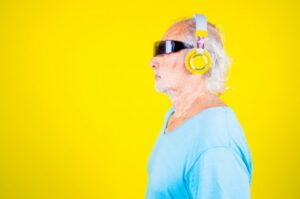 There is no doubt that the baby boomer generation and beyond will demand technology that supports aging in place. There is a timely opportunity to invent in this space and use the power of IP to protect your innovative efforts.
There is no doubt that the baby boomer generation and beyond will demand technology that supports aging in place. There is a timely opportunity to invent in this space and use the power of IP to protect your innovative efforts.
What may the future look like? Here are a few possible scenarios:
A Flurry of New Products
Many new aging in place products are entering the marketplace. Products such as Life Alert® have existed for decades, but now these products are becoming more advanced and are adding the technologies discussed above. As the population ages and unexpected factors, such as the COVID-19 pandemic, increase the need for at-home care, there will inevitably be a flood of products that respond to these needs. Now is the time to act on the growing market.
Retrofit Existing Homes
Many seniors will prefer to remain in their current home. There will be a thriving industry for adding technology infrastructure improvements to existing homes. These improvements include sensor networks, security cameras, and voice driven interfaces. Many products already can interface via Google Assistant or Amazon Alexa. This trend will continue, with companies competing based on features and cost. However, the winners will be the companies that successfully overcome the issues described by seniors in using technology effectively.
New Homes Designed for Aging in Place
While there will certainly be a preference to remain in one’s home, over time the next generation will recognize that they can purchase and move into an “aging-ready” home. These residences can have the state-of-the-art systems built into them from the start. There will likely be construction groups that specialize in aging in place technology design and installation, and the cost of these systems will be built into the purchase price.
Insurance Programs that Cover Aging in Place
 Medical insurance and long-term care policies will incorporate the use of aging in place technology to help reduce medical claims and cost. Approved aging in place products and services will help to reduce premiums and increase longevity/health of the policyholders.
Medical insurance and long-term care policies will incorporate the use of aging in place technology to help reduce medical claims and cost. Approved aging in place products and services will help to reduce premiums and increase longevity/health of the policyholders.
Introduction of Robotics into the Home
Robotics advancements will permit in-home care to advance to a new level. While small devices such as a Roomba can execute home tasks, larger, interactive robots will soon assist with other forms of care. A robot does not get injured or tire of repeated needs for mobility assistance. A sophisticated home robot can easily help a senior out of bed or up from the floor. Other stationary robotics systems could assist with other home chores such as cooking and laundry. Robots may eventually provide medical assistance, under direction/control of medical personnel.
Companies that seek to develop products and services in the aging in place landscape should take full advantage of IP protection, such as patents, trade secrets, publications, and trademarks. As this is expected to quickly become a crowded space, with some large companies like Philips, IBM, Cerner already beginning to stake a claim with patents, IP is a critical factor to reduce risk of your investment.
Will You Participate in the Aging in Place Opportunity?
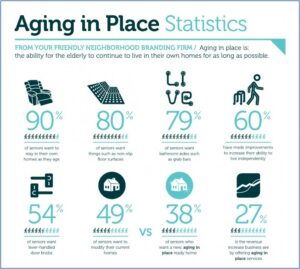 Statistics clearly show that there is a demand for aging in place (See Figure 3). Will you be part of creating new solutions and bringing them to market? Are you reacting quickly enough? Our observation is that in the current environment of agile/lean development, easily accessed technology and high numbers of startups, a new market quickly becomes saturated. Companies will certainly take advantage of the opportunity. The only question is whether you will be a participant in it.
Statistics clearly show that there is a demand for aging in place (See Figure 3). Will you be part of creating new solutions and bringing them to market? Are you reacting quickly enough? Our observation is that in the current environment of agile/lean development, easily accessed technology and high numbers of startups, a new market quickly becomes saturated. Companies will certainly take advantage of the opportunity. The only question is whether you will be a participant in it.
Figure 3
Please contact us if you want to discuss how to map out this area to find white space, invent to own IP, and create an IP strategy in the aging in place space to support your company’s development efforts.

